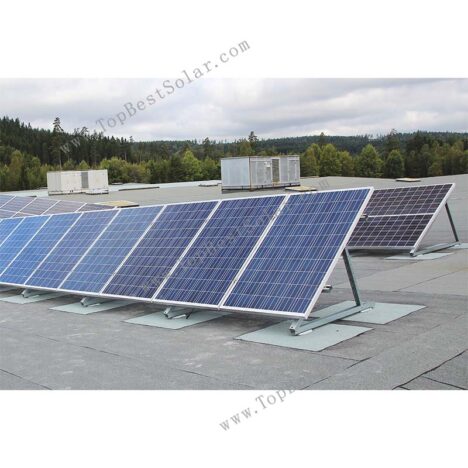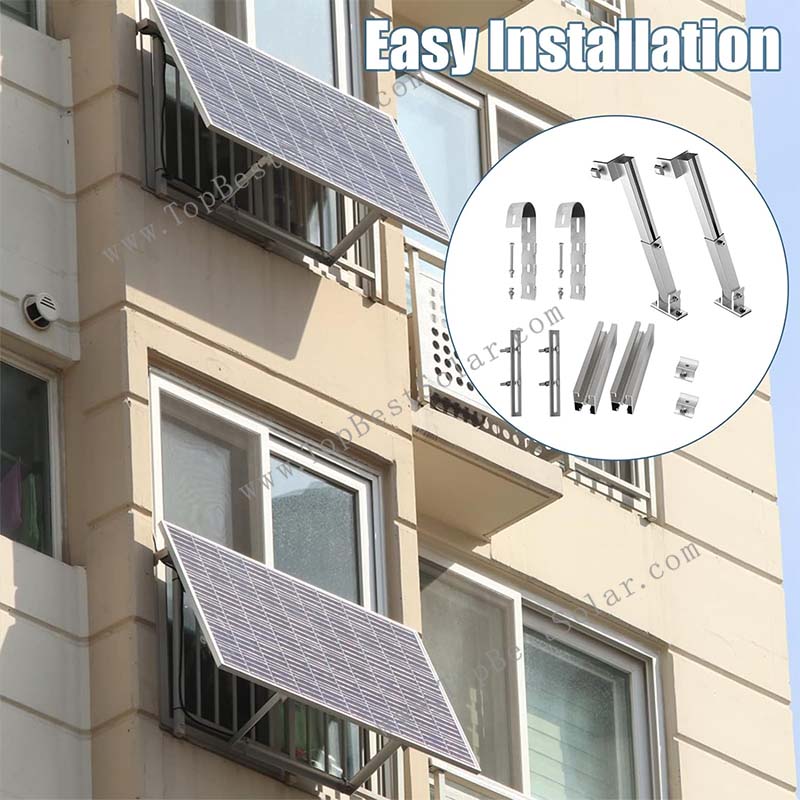
Balcony adjustable solar racking kits
Installation Site : Balcony
Installation Angle : 10° ~ 30°
Profile Material : Aluminium AL6005-T5&SUS 304
Fasten Parts : SUS 304 / A2-70 Stainless Steel
Small Components : AL 6005-T5& Stainless Steel
Color : Silvery or according to customer requirements
Wind Load : 40 m / s
Snow Load : 1.2KN / M2
What Is a Balcony Solar System?
A balcony solar system is a small photovoltaic setup installed on the balcony railings, walls, or floors of an apartment or home. It usually includes:
- 1–2 solar panels (300–800W total)
- Micro inverter or plug-in inverter
- Mounting brackets
- Optional battery or energy meter
Instead of feeding power directly into the main electrical grid, most balcony solar panels are plug-in systems: they connect to a standard wall socket, and the generated electricity immediately powers your home appliances, reducing your grid consumption.
Key Benefits
| Benefit | Description |
| Cost Savings | Cut electricity bills by 10–30% depending on system size and usage. |
| Easy Installation | Simple mounting on railings, minimal tools required. |
| Green Energy | Reduce carbon footprint and dependence on fossil fuels. |
| Ideal for Renters | No roof space needed, easy to remove when moving. |
Components of a Balcony Solar System
- Solar panels: Convert sunlight to DC electricity.
- Micro-inverter: Converts DC to AC for home use.
- Mounting system: Brackets, clamps, or railing hooks.
- Monitoring device (optional): Tracks energy production.
- Battery (optional): Stores excess energy for later use.
How to Install Balcony Solar Panels
Installing a balcony solar system is simple, but safety is crucial. Follow these steps:
- Assess the balcony space: Ensure good sun exposure and strong railing/walls.
- Check regulations: Confirm local building and electrical codes allow plug-in solar.
- Mount the panels: Use sturdy brackets or hooks, angle toward the sun.
- Connect inverter and cables: Follow the manufacturer’s instructions carefully.
- Plug into wall socket: Once secure, plug the inverter into an indoor socket.
- Monitor performance: Use a smart plug or app to track daily production.
⚠️ Safety tip: Never drill into structural parts without permission. Use certified mounting systems.
Conclusion
Balcony solar systems are an accessible, affordable, and eco-friendly way to harness renewable energy — especially for apartment residents with limited space. With falling costs, easy DIY installation, they’re one of the simplest steps toward sustainable living.
If you want to lower your energy bills and contribute to a cleaner future, a balcony solar system is worth serious consideration.
Next Step
- Check our Balcony Solar Mountings buyer’s guide
- Read our guide on Solar Carport Systems for more home solar solutions
Follow us : Facebook
| Balcony adjustable solar racking kit | |
| Item type: | Balcony Solar Mounting System |
| Type : | SPC-BAS |
| Installation Site : | Balcony |
| Installation Angle : | 10° ~ 30° |
| Profile Material : | Aluminium AL6005-T5&SUS 304 |
| Fasten Parts : | SUS 304 / A2-70 Stainless Steel |
| Small Components : | AL 6005-T5& Stainless Steel |
| Color : | Silvery or according to customer requirements |
| Wind Load : | 40 m / s |
| Snow Load : | 1.2KN / M2 |
| PV Modules : | Frame solar Module |
| Module Orientation : | Landscape |
| Warranty | 10 years |
| Designed LifeSpan | 25 years |
| Packing Details : | |
| Inner : | Bubble bag+inner box+Carton |
| Outer : | Wooden Box, Steel Pallet, MDF, etc |
Frequently Asked Questions
Q: How much power can balcony solar panels produce?
A: A typical 800W system can generate 3–4 kW·h day in sunny conditions.
Q: Do I need a permit?
A: In most regions, small plug-in systems don’t require permits, but always check local rules.
Q: Can I install it if I rent my apartment?
A: Yes — balcony solar is ideal for renters because it’s non-permanent and easy to remove.
Q: Will it work on cloudy days or in winter?
A: Yes, production is lower but still contributes to energy savings.
Q: Is it safe to plug into a wall socket?
A: Yes, if using a certified micro-inverter and grounded outlet. Always follow safety instructions.
- Description
-
What Is a Balcony Solar System?
A balcony solar system is a small photovoltaic setup installed on the balcony railings, walls, or floors of an apartment or home. It usually includes:
- 1–2 solar panels (300–800W total)
- Micro inverter or plug-in inverter
- Mounting brackets
- Optional battery or energy meter
Instead of feeding power directly into the main electrical grid, most balcony solar panels are plug-in systems: they connect to a standard wall socket, and the generated electricity immediately powers your home appliances, reducing your grid consumption.
Key Benefits
Benefit Description Cost Savings Cut electricity bills by 10–30% depending on system size and usage. Easy Installation Simple mounting on railings, minimal tools required. Green Energy Reduce carbon footprint and dependence on fossil fuels. Ideal for Renters No roof space needed, easy to remove when moving. Components of a Balcony Solar System
- Solar panels: Convert sunlight to DC electricity.
- Micro-inverter: Converts DC to AC for home use.
- Mounting system: Brackets, clamps, or railing hooks.
- Monitoring device (optional): Tracks energy production.
- Battery (optional): Stores excess energy for later use.
How to Install Balcony Solar Panels
Installing a balcony solar system is simple, but safety is crucial. Follow these steps:
- Assess the balcony space: Ensure good sun exposure and strong railing/walls.
- Check regulations: Confirm local building and electrical codes allow plug-in solar.
- Mount the panels: Use sturdy brackets or hooks, angle toward the sun.
- Connect inverter and cables: Follow the manufacturer’s instructions carefully.
- Plug into wall socket: Once secure, plug the inverter into an indoor socket.
- Monitor performance: Use a smart plug or app to track daily production.
⚠️ Safety tip: Never drill into structural parts without permission. Use certified mounting systems.
Conclusion
Balcony solar systems are an accessible, affordable, and eco-friendly way to harness renewable energy — especially for apartment residents with limited space. With falling costs, easy DIY installation, they’re one of the simplest steps toward sustainable living.
If you want to lower your energy bills and contribute to a cleaner future, a balcony solar system is worth serious consideration.
Next Step
- Check our Balcony Solar Mountings buyer’s guide
- Read our guide on Solar Carport Systems for more home solar solutions
Follow us : Facebook
- Datasheet
-
Balcony adjustable solar racking kit Item type: Balcony Solar Mounting System Type : SPC-BAS Installation Site : Balcony Installation Angle : 10° ~ 30° Profile Material : Aluminium AL6005-T5&SUS 304 Fasten Parts : SUS 304 / A2-70 Stainless Steel Small Components : AL 6005-T5& Stainless Steel Color : Silvery or according to customer requirements Wind Load : 40 m / s Snow Load : 1.2KN / M2 PV Modules : Frame solar Module Module Orientation : Landscape Warranty 10 years Designed LifeSpan 25 years Packing Details : Inner : Bubble bag+inner box+Carton Outer : Wooden Box, Steel Pallet, MDF, etc - FAQ
-
Frequently Asked Questions
Q: How much power can balcony solar panels produce?
A: A typical 800W system can generate 3–4 kW·h day in sunny conditions.Q: Do I need a permit?
A: In most regions, small plug-in systems don’t require permits, but always check local rules.Q: Can I install it if I rent my apartment?
A: Yes — balcony solar is ideal for renters because it’s non-permanent and easy to remove.Q: Will it work on cloudy days or in winter?
A: Yes, production is lower but still contributes to energy savings.Q: Is it safe to plug into a wall socket?
A: Yes, if using a certified micro-inverter and grounded outlet. Always follow safety instructions. - Leave Message
-

